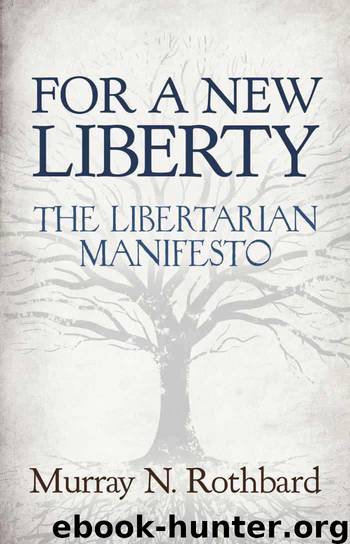For a New Liberty: The Libertarian Manifesto (LvMI) by Rothbard Murray N

Author:Rothbard, Murray N [Rothbard, Murray N]
Language: eng
Format: mobi
Tags: Patriot Bookshelf
ISBN: 9780945466475
Publisher: Ludwig von Mises Institute
Published: 2012-11-06T06:00:00+00:00
THE FEDERAL RESERVE AND
FRACTIONAL RESERVE BANKING
Inflating by simply printing more money, however, is now considered old-fashioned. For one thing, it is too visible; with a lot of high-denomination bills floating around, the public might get the troublesome idea that the cause of the unwelcome inflation is the government’s printing of all the bills—and the government might be stripped of that power. Instead, governments have come up with a much more complex and sophisticated, and much less visible, means of doing the same thing: of organizing increases in the money supply to give themselves more money to spend and to subsidize favored political groups. The idea was this: instead of stressing the printing of money, retain the paper dollars or marks or francs as the basic money (the “legal tender”), and then pyramid on top of that a mysterious and invisible, but no less potent, “checkbook money,” or bank demand deposits. The result is an inflationary engine, controlled by government, which no one but bankers, economists, and government central bankers understands—and designedly so.
First, it must be realized that the entire commercial banking system, in the United States or elsewhere, is under the total control of the central government—a control that the banks welcome, for it permits them to create money. The banks are under the complete control of the central bank—a government institution—a control stemming largely from the central bank’s compulsory monopoly over the printing of money. In the United States, the Federal Reserve System performs this central banking function. The Federal Reserve (“the Fed”) then permits the commercial banks to pyramid bank demand deposits (“checkbook money”) on top of their own “reserves” (deposits at the Fed) by a multiple of approximately 6:1. In other words, if bank reserves at the Fed increase by $1 billion, the banks can and do pyramid their deposits by $6 billion—that is, the banks create $6 billion worth of new money.
Why do bank demand deposits constitute the major part of the money supply? Officially, they are not money or legal tender in the way that Federal Reserve Notes are money. But they constitute a promise by a bank that it will redeem its demand deposits in cash (Federal Reserve Notes) anytime that the depositholder (the owner of the “checking account”) may desire. The point, of course, is that the banks don’t have the money; they cannot, since they owe six times their reserves, which are their own checking account at the Fed. The public, however, is induced to trust the banks by the penumbra of soundness and sanctity laid about them by the Federal Reserve System. For the Fed can and does bail out banks in trouble. If the public understood the process and descended in a storm upon the banks demanding their money, the Fed, in a pinch, if it wanted, could always print enough money to tide the banks over.
The Fed, then, controls the rate of monetary inflation by adjusting the multiple (6:1) of bank money creation, or, more importantly, by determining the total amount of bank reserves.
Download
This site does not store any files on its server. We only index and link to content provided by other sites. Please contact the content providers to delete copyright contents if any and email us, we'll remove relevant links or contents immediately.
| Anarchism | Communism & Socialism |
| Conservatism & Liberalism | Democracy |
| Fascism | Libertarianism |
| Nationalism | Radicalism |
| Utopian |
The Secret History by Donna Tartt(18113)
The Social Justice Warrior Handbook by Lisa De Pasquale(11946)
Thirteen Reasons Why by Jay Asher(8431)
This Is How You Lose Her by Junot Diaz(6422)
Weapons of Math Destruction by Cathy O'Neil(5809)
Zero to One by Peter Thiel(5473)
Beartown by Fredrik Backman(5331)
The Myth of the Strong Leader by Archie Brown(5225)
The Fire Next Time by James Baldwin(5005)
How Democracies Die by Steven Levitsky & Daniel Ziblatt(4946)
Promise Me, Dad by Joe Biden(4903)
Stone's Rules by Roger Stone(4841)
100 Deadly Skills by Clint Emerson(4678)
Rise and Kill First by Ronen Bergman(4540)
A Higher Loyalty: Truth, Lies, and Leadership by James Comey(4539)
Secrecy World by Jake Bernstein(4375)
The David Icke Guide to the Global Conspiracy (and how to end it) by David Icke(4370)
The Farm by Tom Rob Smith(4314)
The Doomsday Machine by Daniel Ellsberg(4236)
